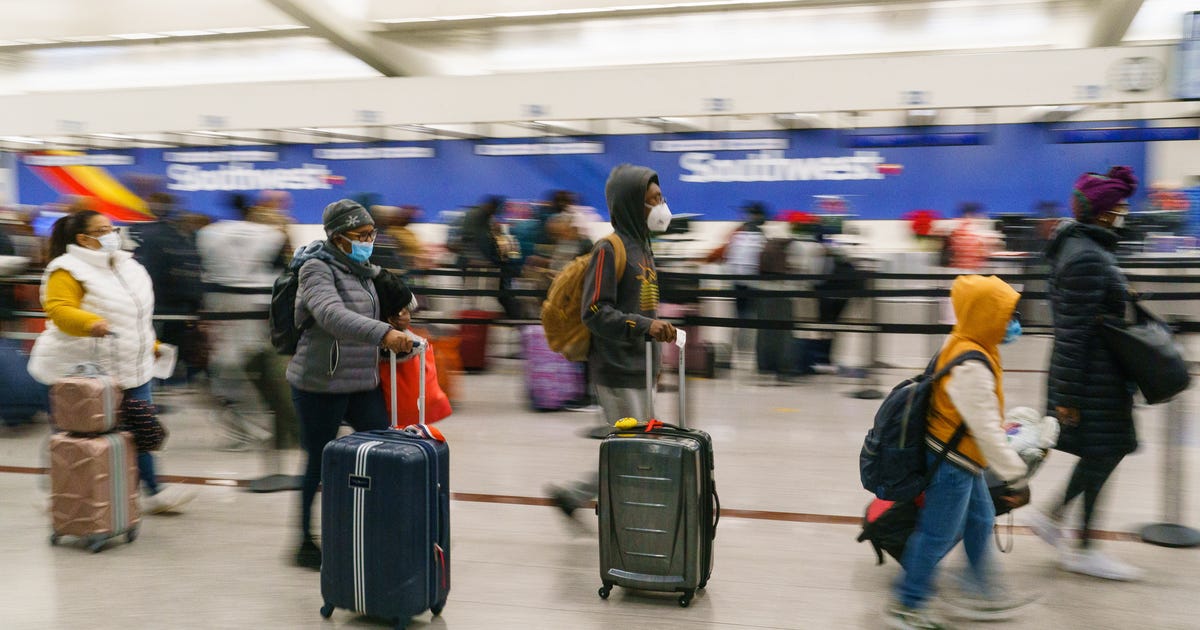
“First time on a plane in over 15 months,” I wrote on Instagram on May 1, 2021. “A bit freakish, but man, did I miss traveling.” Along with the caption, I posted a selfie of myself from the San Antonio, Texas, airport, wearing a mask aboard a full Aeromexico flight bound to Mexico City.
It certainly was a bit scary to be in the wild again, surrounded by crowds of masked travelers. The persistence of the coronavirus pandemic continues to keep many former fellow voyagers grounded – despite a surge in holiday travel versus a year ago, it’s still below pre-pandemic levels, according to AAA – and wondering when they will be able to travel safely again.
But I was so ready to endure all the travails that come with flying during the COVID-19 era in order to see my loved ones again. I wasn’t alone. That May, US airline passengers increased more than 600% from May 2020, according to the US government’s Bureau of Transportation Statistics.
Even if you can get past the COVID concerns, travel has dramatically changed. Long gone are the days when you could hop on a plane on a whim. Traveling now requires a strenuous series of additional calculations in order for you to stay safe, make sure you can return home as planned and not break the bank.
This includes getting the right COVID test, finding a place at the airport where you can keep a safe distance from other passengers, booking airfares that should be both affordable and refundable in case your plans change, and really, really tempering your expectations about what it means to find bliss while traveling.
Oh, and making sure you don’t get infected with the coronavirus during your trip. With the unpredictable surges over the last several months – thanks, delta and omicron – would-be travelers were forced to make difficult choices with constantly shifting levels of risk and guidelines.
Is it worth it, though? With my 75-year-old mother living in Mexico and my two sons recently moved out of the house – one to New York and the other to Spain – sitting out the pandemic ad infinitum was not an option. Since last year, I have traveled twice each to Mexico City and Madrid, first in the early summer and then around the holidays.
During those four trips, making sure I didn’t test positive for COVID-19 and put my loved ones at risk was my top priority. Here’s how I managed.
1. Getting boosted
As soon as vaccines were available, I went out of my way to find a time slot to get vaccinated. By early April, I had received my second dose of the Moderna vaccine. But that was just half of the equation. Vaccination campaigns moved a bit more slowly in Mexico, but by late April, my mom had received both jabs of the Pfizer vaccine. Only then did I feel comfortable booking my flight.
In the fall, the delta variant was already everywhere, so getting a Moderna booster shot before my second round of trips was a must. Boosters had just become available, so finding an open spot took time. Luckily, I found a clinic an hour’s drive from home two days before my departure.
When I headed to the airport, I felt a renewed sense of safety. Recent data shows that a third dose of the vaccine increases antibody production and boosts effectiveness against infection to around 75%, according to CNET sister site Healthline.
2. Getting priority access through airport security
Basic safety rules to prevent exposure to the coronavirus haven’t changed since the pandemic started. The CDC recommends getting vaccinated (check), wearing a mask (check), staying six feet away from others and avoiding crowds and poorly ventilated spaces.
Those last two recommendations can be hard to follow in airports. Luckily, TSA Pre, Global Entry and Clear all helped me through airport security faster, reducing the time I had to spend in line surrounded by crowds. The good news is that a couple of my credit cards offer TSA Pre, Global Entry and Clear credits so I didn’t have to pay for them.
Thanks to TSA Pre, I don’t have to remove my shoes or take my laptop out of my bag at security checks. Global Entry gives me access to an express line through customs and immigration on my way back to the US.
If you sign up for Global Entry ($100 for five years), you also get access to TSA Pre. If you only travel domestically, TSA Pre costs $85 for five years. I travel internationally as frequently as I do around the country, so signing up for Global Entry and having both was a no-brainer. To pay for it, I used the credits offered by my Chase Sapphire Reserve credit card.
Clear uses biometrics to let you jump right to the front of the main security line or TSA Pre line. At $179 per year, it’s not worth it if you only travel occasionally. I’d never pay for Clear out of pocket, but last year, my Platinum Card from American Express added Clear to its roster of travel benefits. I immediately signed up and have enjoyed it in all my trips since.
3. Waiting for flights at airport lounges
Airport lounges usually give you access to strong Wi-Fi, good food options and other amenities for free. But during the pandemic, I’ve been frequenting them mainly to avoid crowds.
Most of the time, these places offer more space to rest, eat or work while you wait for your flight. In my recent trips, lounges allowed me to stay at least six feet away from other travelers, giving me extra peace of mind, especially when I had to remove my mask to eat or drink.
Airport lounge access can be pricey, though – a Priority Pass membership, which gives you access to hundreds of lounges around the world, can run up to $429 a year. Luckily, several travel credit cards offer lounge access for free – including the two in my wallet I mentioned earlier, Chase Sapphire Reserve and Amex Platinum. And depending on the airport and credit card you have, you might have more than one lounge to choose from. Before every trip, I like to check out my options on the Lounge Buddy app.
4. Booking refundable airline tickets
Many airlines have made it easier to cancel or reschedule flights during the pandemic to lure travelers back. However, this remains a moving target, forcing travelers to stay on top of airline rules and read the fine print of that flight ticket before hitting the purchase button.
Making sure you get your money back if your travel plans change has never been more important. Here are a few things I’ve learned as I booked my flights to Mexico and Spain.
- Basic economy fares are a trap. Last summer, I mistakenly bought a $1,200 American Airlines basic economy flight to Madrid. When my plans changed and I needed to extend my stay, I couldn’t reschedule or cancel the flight. Basic economy tickets might look affordable at first but are also the most restrictive – not to mention all the extra fees that come with them, from selecting a seat to bringing a carry-on on board. Most importantly, very few airlines will allow you to cancel or reschedule a basic economy ticket at all.
- Fully refundable fares offer great flexibility but are more expensive. There are all kinds of economy fares, some more restrictive than others. If you anticipate you might need to cancel, consider paying a bit more and purchase a fully refundable fare.
- Travel-voucher fares hit the sweet spot between affordability and convenience. If, that is, you plan to travel with the same airline again soon. If you cancel these tickets, you’ll receive a travel voucher for the full amount to use on another flight at a later date, usually through the end of next year.
- Miles and points usually can unlock the most flexible and affordable fares. This varies from airline to airline, too, but in my experience, airlines would usually reinstate the miles to your account if you cancel a flight. And you don’t have to travel constantly to accrue enough miles for a trip. The best rewards credit cards will let you earn points and miles on everyday purchases.
5. Using at-home CDC-approved COVID-19 tests to meet US reentry requirements
For most of the trips I made last year, a negative rapid antigen test, taken at least 72 hours before travel, was enough to be allowed back in the US. But with the rise of the omicron variant, travel restrictions changed again in early December. Now the same test has to be taken one day before travel.
This would throw a curveball for my family’s holiday travel plans, as my wife and older son had to fly back home from Spain on Jan. 2, their tests had to be taken Jan. 1, a holiday everywhere.
Luckily, this guide to at-home COVID-19 tests for international travel at CNET sister site The Points Guy came to the rescue. It mentioned three tests approved by the CDC to meet US entry requirements, including Abbott’s BinaxNow COVID-19 Ag At-Home test kits.
I bought a $99 three-pack at Optum before our trip. The day before we flew back home, we took the tests from my mother-in-law’s in southern Spain. The process was easy and convenient – just make sure to have a good internet connection. You’ll need to join a video session with a virtual assistant, who’ll walk you through the test and verify your results.
I will keep using these at-home tests on my future trips, even if I have to pay for them out of pocket. The Biden administration just made at-home COVID-19 tests free, but these aren’t valid for travel. A pack of six of those BinaxNow test kits for travel from Abbott’s costs $150 on eMed.com.
6. Settling for safety first versus fun first
While abroad, I chose to only engage in activities that felt safe. That meant not going to the movies with my mom when I was in Mexico in May or skipping dinner at restaurants in Spain during the fall if outdoor seating wasn’t an option. I stuck with safe instead of risking for fun. I haven’t traveled for leisure since March 2020. All these trips were critical to my mental and emotional health.
To me, the most important thing about traveling during the pandemic has been the opportunity to see those I love again. A vast majority of Americans live close to the place where they grew up – but that’s not my case. For a family of immigrants whose friends, parents, siblings and now even children are scattered across the globe, jumping on a plane to reunite with them has helped us push through one of the most uncertain periods of our lives.
The information contained in this article is for educational and informational purposes only and is not intended as health or medical advice. Always consult a physician or other qualified health provider regarding any questions you may have about a medical condition or health objectives.

